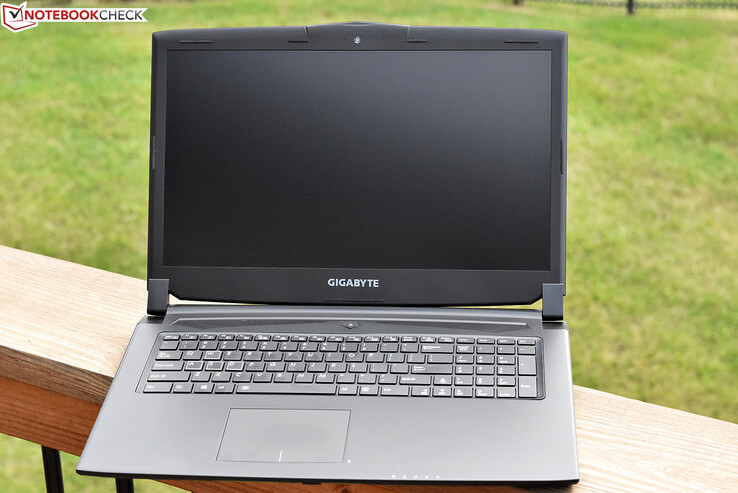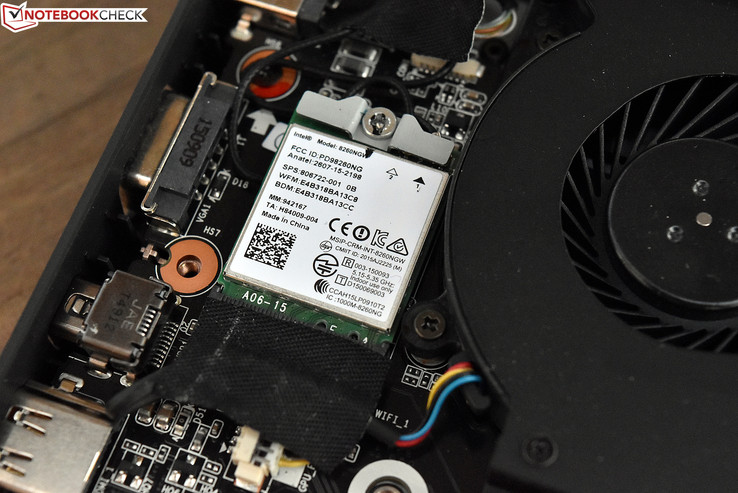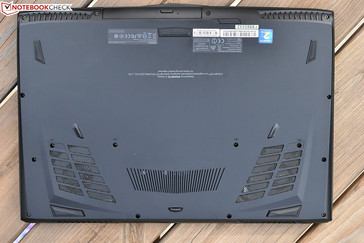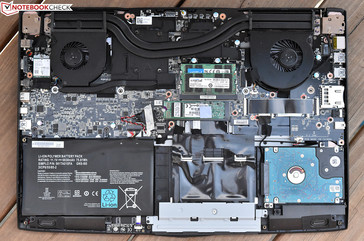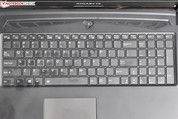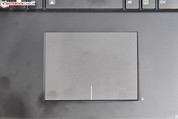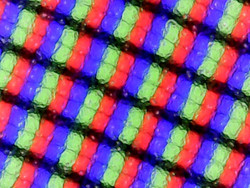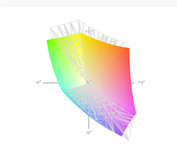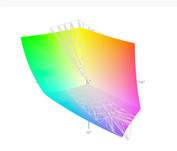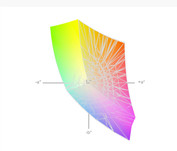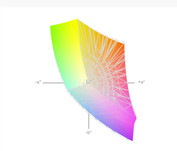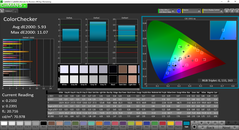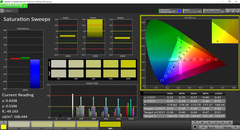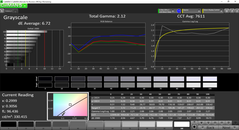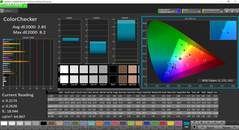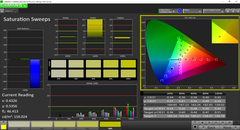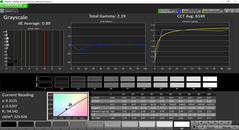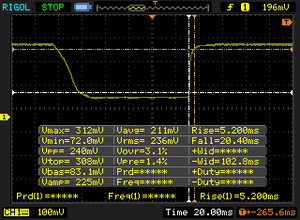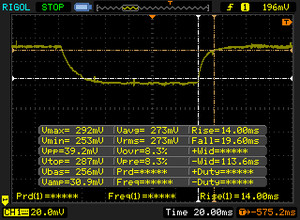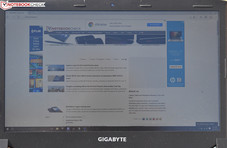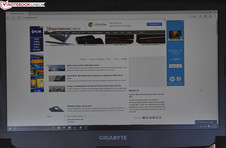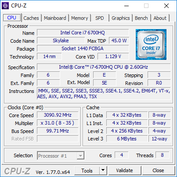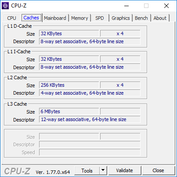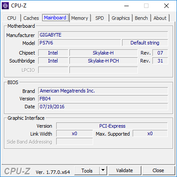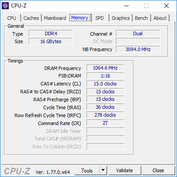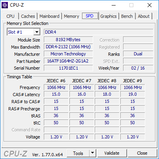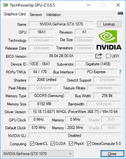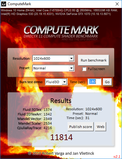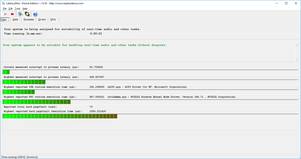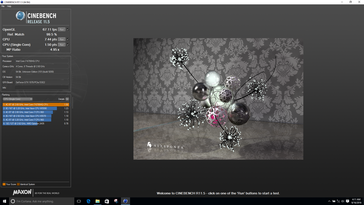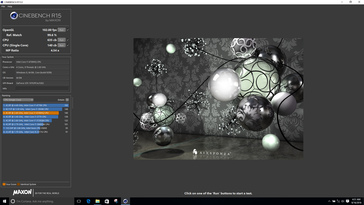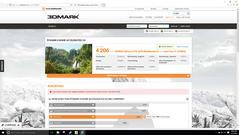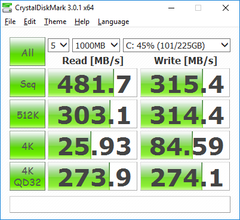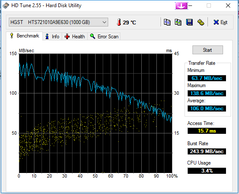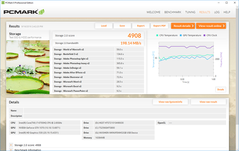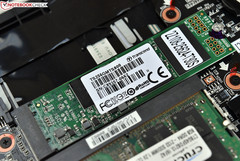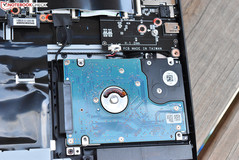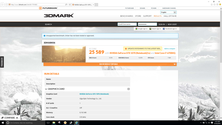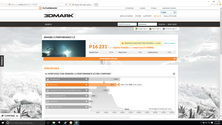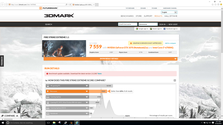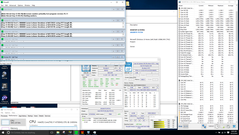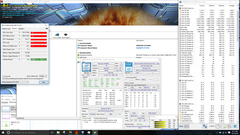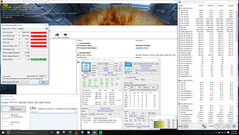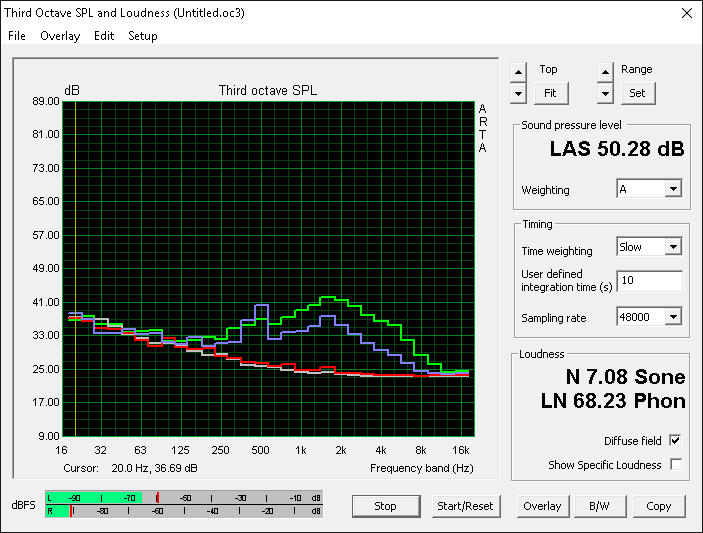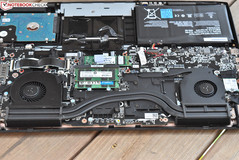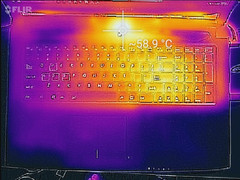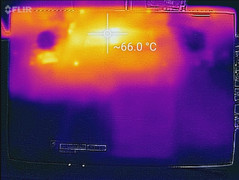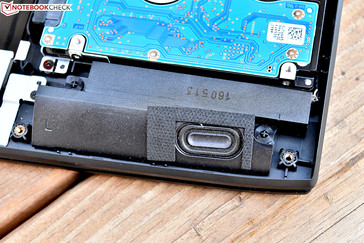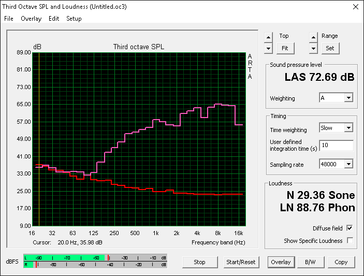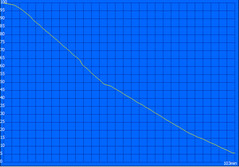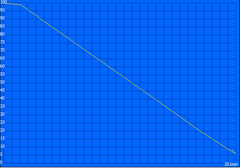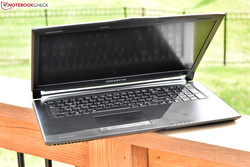Gigabyte P57X v6 Notebook Review

It feels like April all over again. Or, at least, initially: just six months ago, we reviewed the Gigabyte P57W, from which the P57X was born. Both machines are nearly identical in terms of their casing, port layouts, and even most specifications—but the latter now features a formidable NVIDIA GeForce GTX 1070 (Laptop), which is a significant upgrade (to put it lightly) from the GTX 970M of its predecessor.
Elsewhere, the same solid specs apply: Intel Core i7-6700HQ, 16 GB of DDR4-2133 RAM, dual storage drive configuration (256 GB M.2 SSD + 1 TB HDD), 17.3-inch 1080p IPS display, 75 Wh battery. Competitively priced at $1,999, there’s an awful lot of power under the hood of this machine. Can it hold up under the scrutiny of our tests?
Case
The P57X case is extremely similar to that of the P57W. As before, it’s primarily comprised of matte black plastic; although it can’t compete with the stability and feel of metal, the material does feel somewhat heavier than the chintzy stuff you’ll find on typical mainstream consumer-grade notebooks. Stability is good overall, with not much yield across the breadth of the base unit under pressure, and only the somewhat flimsier display lid left to foster any doubt. A fairly manageable weight of just 3.25 kg (7.2 lbs) is made possible by the choice of construction materials—a good asset when one factors in the comparably massive power brick (938 g).
To accompany its lighter-than-expected weight is a shrunken form factor for a 17.3-inch gaming notebook as well. Measuring just 31 mm at its thickest point, and sitting with a footprint of 296 mm x 418 mm, it’s considerably smaller than most other notebooks in its class, especially the Acer Predator 17 and Asus G752VS, both of which are quite a bit thicker and wider than the P57X.
The notebook is also particularly nondescript for a gaming model, featuring almost none of the colorful flair and flashy theatrics of its peers apart from a neon-colored orange highlight lining the hinge covers. It’s all business and no fluff with the Gigabyte P57X, and there’s nothing really wrong with that. Speaking of hinges, the P57X’s are rather light with their grip, which enables one-handed opening of the machine, but which also can result in a bouncy display in rocky conditions.
Connectivity
Yet again, here, nothing has changed from the previous P57W. You still receive four total USB ports, three of which are USB 3.1 Gen 1 and the fourth of which is a USB 3.1 Gen 2 Type-C port. There’s also three total video output options between HDMI, mini-DisplayPort, and VGA. Port placement is overall good.
Also returning is the expansion bay, which came populated in our instance by a DVD-RAM drive. Packed in the box is an empty bracket to save weight should you deem the DVD drive unnecessary (and these days, you quite likely may).
SD Card Reader
As show in the below graphs, our SD card tests resulted in an average transfer speed of 76 MB/s, which is reasonably fast, though far from the fastest we have measured. Sequential read speeds are a bit higher at close to 90 MB/s.
| SD Card Reader | |
| average JPG Copy Test (av. of 3 runs) | |
| MSI GT72VR 6RD-063US | |
| Acer Predator 17 G9-793-77LG | |
| Gigabyte P57X v6 | |
| Asus G752VS-XB78K | |
| Lenovo IdeaPad Y900 | |
| maximum AS SSD Seq Read Test (1GB) | |
| MSI GT72VR 6RD-063US | |
| Lenovo IdeaPad Y900 | |
| Gigabyte P57X v6 | |
| Acer Predator 17 G9-793-77LG | |
| Asus G752VS-XB78K | |
Communication
The WLAN adapter in the Gigabyte P57X has not changed since the previous model. The Intel Dual-Band Wireless-AC 8260 adapter has been extensively tested here at Notebookcheck, and during our test period with the P57X, we experienced no issues with connectivity: speeds were fast, and reception was strong. This adapter also provides Bluetooth 4.1 + LE functionality.
On the Ethernet front, the designated adapter is the Realtek Gaming GBE Family Controller, which produced good, consistent speeds during our tests. See our graph for more detail.
| Networking | |
| iperf Server (receive) TCP 1 m 512KB | |
| Lenovo IdeaPad Y900 | |
| Gigabyte P57X v6 | |
| iperf Client (transmit) TCP 1 m 512KB | |
| Lenovo IdeaPad Y900 | |
| Gigabyte P57X v6 | |
Accessories
The Gigabyte P57X ships with a rather large 200 W AC adapter (938 g), which brings the total carry weight for the system to around 4.2 kg. Also included is a driver DVD and owner’s manual (vintage!), as well as a bay adapter for a 2.5” hard drive or SSD. The bay is easily swapped from the front edge of the machine; installed by default is the aforementioned DVD-RAM drive, but it’s easy to add another storage drive (for a grand total of three) using the included adapter.
Software
Normally, there isn’t a lot to talk about here, but Gigabyte does include a very useful software suite in their SmartManager application. From here, the user is granted granular control over a range of different aspects of the machine, including both fan speed and GPU overclocking. These choices are made easy by a no-nonsense interface featuring scales of 1 through 5 for both features, and both Automatic and Manual fan speed controls (explained in more detail later in the Noise and Temperatures sections of this review).
Also included are two other applications: Smart Update and Smart USB Backup. The former is a slick, easy-to-use list of all primary device drivers installed on the machine, as well as a list of available updates (including, optionally, Beta versions) for those drivers. Simply clicking an update version installs the driver—simple. Smart USB Backup, meanwhile, produces bootable recovery media should your operating system ever fail to start.
Maintenance
Maintenance is relatively easy—provided you’ve got a little time to remove sixteen screws securing the bottom cover to the machine. Once inside, you will find access to just about every replaceable component, including all storage devices (up to 3), the battery, both RAM SODIMMs, the cooling fans, and the CMOS battery.
Warranty
The Gigabyte P57X includes a 2-year depot warranty standard. Please see our Guarantees, Return Policies & Warranties FAQ for country-specific information.
Input Devices
Keyboard
The P57X’s chiclet keyboard features what Gigabyte refers to as “anti-ghosting” technology, meaning that it can handle multiple keypresses on the same axis without losing or delaying keystrokes. Solutions to this problem require more expensive implementations of keyboard circuitry, but it’s something which gamers specifically are likely to appreciate. Still, in spite of this, the keyboard itself is merely passable. Keys are spaced well and we found few complaints with the layout, but the quality of keypresses (which feature a very short travel distance) doesn’t seem up to par with that of many other high-end laptops. Key travel is partially a matter of taste, however, and at least actuation force and feedback are both fairly well-tuned. The keyboard is also backlit, with two brightness options—in addition to automatic—available for selection. Finally, since this is a 17.3-inch machine, the keyboard also features a number pad off to the right.
One other item of note is the keyboard’s penchant for collecting fingerprints and skin oils, both of which are quite difficult to remove. You can witness some of this for yourself in our photos.
Touchpad
Our experience with the ELAN touchpad, meanwhile, was not so positive. Although it features a spacious surface and responsive and accurate pointer control, the integrated buttons—with their mushy, ambiguous operation—border on unusable. We experienced phantom clicks when pressure was applied to the palm rest (such as when the PC was gripped from the lower-left side of the case), and drag-and-drop operations were unnecessarily challenging, so much so that we generally opted for keyboard shortcuts to accomplish the same tasks (CTRL+P/V, etc.) instead.
Of course, gamers will most often be using an external mouse of some sort during their time with the machine, but it’s still frustrating to have to deal with such a suboptimal input device in between those times.
Display
The 17.3-inch, 1920x1080 IPS display on the Gigabyte P57X features a matte finish. With a PPI of 127, it’s on the lower side for screens of this size, but that also means that gaming at native resolutions should present few, if any, issues—and battery life should benefit as well. Subjectively, the screen appears to have good contrast and brightness and reasonably attractive color reproduction. However, we did note some conspicuous backlight bleeding along the bottom of the screen.
| |||||||||||||||||||||||||
Brightness Distribution: 93 %
Center on Battery: 329.2 cd/m²
Contrast: 1233:1 (Black: 0.267 cd/m²)
ΔE ColorChecker Calman: 5.93 | ∀{0.5-29.43 Ø4.78}
ΔE Greyscale Calman: 6.72 | ∀{0.09-98 Ø5}
87% sRGB (Argyll 1.6.3 3D)
57% AdobeRGB 1998 (Argyll 1.6.3 3D)
64% AdobeRGB 1998 (Argyll 3D)
87.5% sRGB (Argyll 3D)
68% Display P3 (Argyll 3D)
Gamma: 2.12
CCT: 7611 K
| Gigabyte P57X v6 LGD0469, IPS, 17.3", 1920x1080 | Lenovo IdeaPad Y900 17.3", 1920x1080 | MSI GT72VR 6RD-063US LG Philips LGD046E, IPS, 17.3", 1920x1080 | Acer Predator 17 G9-793-77LG AU Optronics B173ZAN01.0 (AUO109B), IPS, 17.3", 3840x2160 | EVGA SC17 IPS, 17.3", 3840x2160 | Asus G752VS-XB78K LG Philips LP173WF4-SPF3 (LGD04E8), IPS, 17.3", 1920x1080 | Gigabyte P57W LG Philips LP173WF4-SPF1 (LGD0469), IPS, 17.3", 1920x1080 | |
|---|---|---|---|---|---|---|---|
| Display | -1% | -1% | 32% | 33% | -3% | -3% | |
| Display P3 Coverage (%) | 68 | 67.4 -1% | 67.6 -1% | 86.9 28% | 87.6 29% | 66.9 -2% | 66.5 -2% |
| sRGB Coverage (%) | 87.5 | 86.3 -1% | 86.2 -1% | 100 14% | 100 14% | 85.2 -3% | 84.4 -4% |
| AdobeRGB 1998 Coverage (%) | 64 | 63.2 -1% | 63 -2% | 99.4 55% | 99 55% | 62.3 -3% | 61.7 -4% |
| Response Times | -2% | -3% | -2% | -82% | 1% | -2% | |
| Response Time Grey 50% / Grey 80% * (ms) | 33.6 ? | 34.8 ? -4% | 34.4 ? -2% | 37 ? -10% | 69.6 ? -107% | 38 ? -13% | 37 ? -10% |
| Response Time Black / White * (ms) | 25.6 ? | 25.6 ? -0% | 26.4 ? -3% | 24 ? 6% | 40 ? -56% | 22 ? 14% | 24 ? 6% |
| PWM Frequency (Hz) | 1000 ? | ||||||
| Screen | 2% | 7% | 20% | 6% | 8% | 0% | |
| Brightness middle (cd/m²) | 329.2 | 344.9 5% | 351.7 7% | 336 2% | 394.1 20% | 328 0% | 286 -13% |
| Brightness (cd/m²) | 321 | 329 2% | 339 6% | 320 0% | 368 15% | 317 -1% | 274 -15% |
| Brightness Distribution (%) | 93 | 86 -8% | 91 -2% | 88 -5% | 83 -11% | 88 -5% | 87 -6% |
| Black Level * (cd/m²) | 0.267 | 0.349 -31% | 0.37 -39% | 0.25 6% | 0.439 -64% | 0.3 -12% | 0.31 -16% |
| Contrast (:1) | 1233 | 988 -20% | 951 -23% | 1344 9% | 898 -27% | 1093 -11% | 923 -25% |
| Colorchecker dE 2000 * | 5.93 | 4.49 24% | 3.71 37% | 3.61 39% | 5.79 2% | 3.74 37% | 4.49 24% |
| Colorchecker dE 2000 max. * | 11.07 | 8.72 21% | 8.48 23% | 6.02 46% | 8.44 24% | 8.97 19% | 7.83 29% |
| Greyscale dE 2000 * | 6.72 | 4.63 31% | 2.46 63% | 4.78 29% | 4.23 37% | 2.67 60% | 4.76 29% |
| Gamma | 2.12 104% | 2.11 104% | 2.29 96% | 2.32 95% | 2.11 104% | 2.41 91% | 2.47 89% |
| CCT | 7611 85% | 6905 94% | 6849 95% | 6185 105% | 7479 87% | 6861 95% | 6843 95% |
| Color Space (Percent of AdobeRGB 1998) (%) | 57 | 56.7 -1% | 56.6 -1% | 88 54% | 86.6 52% | 56 -2% | 55 -4% |
| Color Space (Percent of sRGB) (%) | 87 | 86.4 -1% | 86.1 -1% | 100 15% | 100 15% | 85 -2% | 84 -3% |
| Total Average (Program / Settings) | -0% /
1% | 1% /
4% | 17% /
19% | -14% /
-0% | 2% /
5% | -2% /
-1% |
* ... smaller is better
We measured an average brightness of 321 cd/m² along with a contrast ratio of 1233:1—both of which are good values. The strong contrast performance is thanks to a very low black value of 0.267 cd/m². The brightness distribution of 93% also indicates a very consistent illumination across the breadth of the panel, an assertion with which our impressions agree.
According to our measurements, the panel covers 87% of the sRGB spectrum—sufficient for most uses, but suboptimal for those seeking the sort of color accuracy necessary for serious photo editing or graphic design. AdobeRGB 1998 coverage is, of course, quite a bit lower at just 57%.
CalMAN 5 provides a more detailed look at the machine’s color reproduction, which is (out of the box) merely decent. Oranges, blues, and greys are particularly deviant, with DeltaE2000 values exceeding 8 and, in the case of white, reaching 11. Total Gamma was measured at 2.12 (ideal: 2.2), and although the CCT average was a rather cool 7611, it can be easily adjusted upwards or downwards using the included Smart Color application, which allows the user to select the desired color temperature for the display.
Display Response Times
| ↔ Response Time Black to White | ||
|---|---|---|
| 25.6 ms ... rise ↗ and fall ↘ combined | ↗ 5.2 ms rise | |
| ↘ 20.4 ms fall | ||
| The screen shows relatively slow response rates in our tests and may be too slow for gamers. In comparison, all tested devices range from 0.1 (minimum) to 240 (maximum) ms. » 60 % of all devices are better. This means that the measured response time is worse than the average of all tested devices (20.2 ms). | ||
| ↔ Response Time 50% Grey to 80% Grey | ||
| 33.6 ms ... rise ↗ and fall ↘ combined | ↗ 14 ms rise | |
| ↘ 19.6 ms fall | ||
| The screen shows slow response rates in our tests and will be unsatisfactory for gamers. In comparison, all tested devices range from 0.165 (minimum) to 636 (maximum) ms. » 45 % of all devices are better. This means that the measured response time is similar to the average of all tested devices (31.6 ms). | ||
Screen Flickering / PWM (Pulse-Width Modulation)
| Screen flickering / PWM not detected | |||
In comparison: 53 % of all tested devices do not use PWM to dim the display. If PWM was detected, an average of 8108 (minimum: 5 - maximum: 343500) Hz was measured. | |||
Performance
For the most part, the P57X maintains the same basic hardware configuration as the previous P57W, with a very capable Intel Core i7-6700HQ at the center of the equation, and 16 GB of DDR4-2133 RAM accompanying it. Also on board (and explored in great detail in a bit) is a dual-storage configuration of both SSD and HDD. So, what’s new? The GPU, of course, which has stepped up to the NVIDIA GeForce 1070 (from the 970M previously). How much of a difference does this make? We’re about to find out.
Before we jump into that conversation, however, it’s important to note that, predictably, the P57X cannot maintain full-power operation while running on battery power; we recorded a 3DMark 11 score of 7010 while running unplugged (compared with 8366 originally). On the other hand, the previously mentioned Smart Manager allows GPU overclocking which ranges from “Level 1” up to “Level 5”; at Level 5, Gigabyte claims that performance is boosted by roughly 10% in benchmarks. Our test results seemed consonant with these claims.
LatencyMon showed no issues with real-time audio/video streaming latencies.
Processor
We have extensively covered the Core i7-6700HQ here at Notebookcheck, and it’s a common inclusion in modern gaming notebooks. Manufactured using a 14 nm architecture and sporting a 45 W TDP, it features Turbo Boost rates of 3.5 GHz (single-core) and 3.1 GHz (quad-core), which the P57X achieves consistently.
As compared to other notebooks featuring the same CPU, including the previous P57W, the P57X wavered a bit more in our benchmarks, sometimes falling behind by as much as 10%. However, this could just as well be a result of cooling differences, as we did not adjust the fan speeds or overclock the GPU during our normal benchmarks on the machine. Overall, the performance is still very strong—and we will determine later in our review whether thermal or TDP throttling happens to be limiting performance in any way.
| Cinebench R11.5 | |
| CPU Single 64Bit | |
| Asus G752VS-XB78K | |
| EVGA SC17 | |
| Lenovo IdeaPad Y900 | |
| Gigabyte P57W | |
| MSI GT72VR 6RD-063US | |
| Gigabyte P57X v6 | |
| CPU Multi 64Bit | |
| Asus G752VS-XB78K | |
| Lenovo IdeaPad Y900 | |
| EVGA SC17 | |
| Gigabyte P57W | |
| Gigabyte P57X v6 | |
| MSI GT72VR 6RD-063US | |
| wPrime 2.10 - 1024m | |
| Gigabyte P57X v6 | |
| MSI GT72VR 6RD-063US | |
| Lenovo IdeaPad Y900 | |
| EVGA SC17 | |
| Super Pi Mod 1.5 XS 32M - 32M | |
| MSI GT72VR 6RD-063US | |
| EVGA SC17 | |
| Lenovo IdeaPad Y900 | |
| Gigabyte P57X v6 | |
* ... smaller is better
System Performance
We use PCMark 8 for synthetic testing of general system performance, and here, the P57X falls right in line where we’d expect. As compared to the P57W, it’s within the margin of error in all three of the primary PCMark 8 performance tests—that is, it performs quite well. Meanwhile, machines leveraging a full-blown NVMe storage configuration, such as the Asus G752VS, manage significantly better results thanks to the greatly enhanced storage speeds these afford. As we’ll see in the next section, the P57X does support NVMe storage—it just didn’t come configured with such a device in this instance.
Subjectively, we had no issues with performance during our time with the P57X. We did find that automatic power plan switching to be an irritation from time to time, but that feature is easily disabled via the included software.
| PCMark 8 | |
| Home Score Accelerated v2 | |
| Asus G752VS-XB78K | |
| Lenovo IdeaPad Y900 | |
| MSI GT72VR 6RD-063US | |
| Gigabyte P57X v6 | |
| Acer Predator 17 G9-793-77LG | |
| Gigabyte P57W | |
| EVGA SC17 | |
| Work Score Accelerated v2 | |
| Asus G752VS-XB78K | |
| Lenovo IdeaPad Y900 | |
| Gigabyte P57X v6 | |
| Gigabyte P57W | |
| MSI GT72VR 6RD-063US | |
| EVGA SC17 | |
| Creative Score Accelerated v2 | |
| Asus G752VS-XB78K | |
| MSI GT72VR 6RD-063US | |
| Lenovo IdeaPad Y900 | |
| Gigabyte P57X v6 | |
| Gigabyte P57W | |
| EVGA SC17 | |
| Acer Predator 17 G9-793-77LG | |
| PCMark 8 Home Score Accelerated v2 | 4206 points | |
| PCMark 8 Creative Score Accelerated v2 | 5192 points | |
| PCMark 8 Work Score Accelerated v2 | 5014 points | |
Help | ||
Storage Devices
The P57X configuration we received includes a Transcend MTS800 256 GB M.2 SSD, which—although it populates the NVMe slot—is not an NVMe drive. As our benchmarks reveal, it is in roughly the same class as the LiteOn drive in the P57W, with somewhat slower sequential write performance but considerably quicker 4k write performance in turn. Again, competitors with NVMe drives (Lenovo Y900, EVGA SC17, Asus G752VS) dominate the charts here, with speeds three and four times as fast as the G57X. But for most users, the Transcend’s performance is just fine—and in case it isn’t, upgrading the internal storage drives is easy.
Regarding that last point, the P57X actually provides support for three simultaneous storage devices: one primary NVMe/M.2 SSD, a secondary 2.5-inch SATA drive, and a tertiary drive in the swappable expansion bay using the included 2.5-inch drive adapter. Since most users no longer have use for an optical drive on a regular basis, this is a terrific solution for backups or even just heaps upon heaps of internal storage. It’s also lighter-weight, which is a welcomed bonus.
The downside? RAID-0 isn’t possible (as is the case with competitors such as the Lenovo Y900 and Asus ROG G752VS, both which feature two side-by-side NVMe-capable M.2 slots). However, standalone NVMe storage is really fast enough for nearly every purpose, so this will not constitute a major loss for most users.
| Gigabyte P57X v6 Transcend MTS800 256GB M.2 (TS256GMTS800) | Lenovo IdeaPad Y900 Samsung SM951 MZVPV256 m.2 | EVGA SC17 Samsung SSD 950 Pro 512GB m.2 NVMe | Asus G752VS-XB78K Toshiba NVMe THNSN5512GPU7 | Gigabyte P57W Lite-On IT L8T-256L9G | |
|---|---|---|---|---|---|
| CrystalDiskMark 3.0 | 159% | 220% | 210% | 6% | |
| Read Seq (MB/s) | 481.7 | 1559 224% | 2247 366% | 1718 257% | 491.6 2% |
| Write Seq (MB/s) | 315.4 | 1254 298% | 1534 386% | 1305 314% | 391.1 24% |
| Read 512 (MB/s) | 303.1 | 850 180% | 1113 267% | 1250 312% | 352.8 16% |
| Write 512 (MB/s) | 314.4 | 1228 291% | 1490 374% | 1438 357% | 371.7 18% |
| Read 4k (MB/s) | 25.93 | 49.32 90% | 52.1 101% | 44.42 71% | 29.89 15% |
| Write 4k (MB/s) | 84.6 | 140.3 66% | 149.2 76% | 154.4 83% | 37.75 -55% |
| Read 4k QD32 (MB/s) | 273.9 | 539 97% | 635 132% | 744 172% | 338.7 24% |
| Write 4k QD32 (MB/s) | 274.9 | 345.3 26% | 422 54% | 578 110% | 278 1% |
GPU Performance
Of course, given acceptably fast performance elsewhere, GPU and gaming performance is the item of true significance here. The single biggest difference between the P57W and P57X is the GPU, which is now a formidable NVIDIA GeForce GTX 1070 (Laptop)—the second-fastest single GPU option currently on the market. And it doesn’t disappoint, either, as we’ll see shortly.
The GTX 1070 is manufactured in 16 nm FinFET and features 2048 shaders. It also packs 8 GB of GDDR5 VRAM and a core speed of 1443 – 1645 MHz. It’s truly a desktop GPU in a mobile package. Let’s see what it can accomplish in the P57X:
| 3DMark | |
| Fire Strike Extreme Graphics | |
| Gigabyte P57X v6 | |
| Asus G752VS-XB78K | |
| MSI GT72VR 6RD-063US | |
| EVGA SC17 | |
| Lenovo IdeaPad Y900 | |
| 1920x1080 Fire Strike Graphics | |
| Asus G752VS-XB78K | |
| Acer Predator 17 G9-793-77LG | |
| MSI GT72VR 6RD-063US | |
| Lenovo IdeaPad Y900 | |
| EVGA SC17 | |
| Gigabyte P57W | |
| 3DMark 11 | |
| 1280x720 Performance GPU | |
| Gigabyte P57X v6 | |
| Asus G752VS-XB78K | |
| Acer Predator 17 G9-793-77LG | |
| Lenovo IdeaPad Y900 | |
| EVGA SC17 | |
| MSI GT72VR 6RD-063US | |
| Gigabyte P57W | |
| 1280x720 Performance Combined | |
| Asus G752VS-XB78K | |
| Lenovo IdeaPad Y900 | |
| EVGA SC17 | |
| Gigabyte P57X v6 | |
| MSI GT72VR 6RD-063US | |
| Gigabyte P57W | |
| Acer Predator 17 G9-793-77LG | |
| 3DMark 06 Standard Score | 25589 points | |
| 3DMark 11 Performance | 16231 points | |
| 3DMark Ice Storm Standard Score | 85198 points | |
| 3DMark Cloud Gate Standard Score | 23781 points | |
| 3DMark Fire Strike Extreme Score | 7559 points | |
Help | ||
The Gigabyte P57X tops the graphics charts, with performance (slightly) exceeding even that of the Asus G752VS, which packs the same video card. Meanwhile, it positively scorches the P57W, which is relegated to last place in our field in 3DMark 11—a whopping 58% behind the new P57X. Clearly, the upgrade to the NVIDIA Pascal cards pays dividends where it truly matters.
Gaming Performance
Of course, real-world results are what really tell the story, and so we turn to our array of game benchmarks (all performed on Ultra settings, thanks to the superfluity of testing anything lower with such a powerful configuration). Here, the Asus G752VS pulls ahead wherever it’s included, which is to be expected considering its quicker CPU and storage—and its $1,000 higher price tag.
However, the P57X absolutely obliterates the rest of the field—basically, anything lacking a GTX 1070. In Rise of the Tomb Raider, the P57X churned out over twice the frame rate of the P57W, and is (at minimum) 65% ahead of anything packing a Maxwell chipset. This trend continues across all games we benchmarked, with the “worst” performance we recorded just 78 frames per second on Ultra settings in Batman: Arkham Knight. The GTX 1070 truly is an amazing piece of hardware.
Of course, some gamers might consequently regret the absence of a 4K display option, since quite obviously, the GPU can handle it. It’s true that this is a bit of a missed opportunity… but regardless, the P57X still supports HDMI 2.0 video output (for HDCP 2.2 monitors) for 4K video output at 60 Hz—so an external monitor is always an option if 4K gaming is of interest. And on the bright side, it’s safe to say that gaming at native resolution (1080p) on the P57X should be possible on high settings for quite some time to come.
| BioShock Infinite - 1920x1080 Ultra Preset, DX11 (DDOF) (sort by value) | |
| Gigabyte P57X v6 | |
| Lenovo IdeaPad Y900 | |
| MSI GT72VR 6RD-063US | |
| EVGA SC17 | |
| Asus G752VS-XB78K | |
| Metro: Last Light - 1920x1080 Very High (DX11) AF:16x (sort by value) | |
| Gigabyte P57X v6 | |
| Lenovo IdeaPad Y900 | |
| MSI GT72VR 6RD-063US | |
| EVGA SC17 | |
| Thief - 1920x1080 Very High Preset AA:FXAA & High SS AF:8x (sort by value) | |
| Gigabyte P57X v6 | |
| Lenovo IdeaPad Y900 | |
| MSI GT72VR 6RD-063US | |
| EVGA SC17 | |
| Asus G752VS-XB78K | |
| Batman: Arkham Knight - 1920x1080 High / On AA:SM AF:16x (sort by value) | |
| Gigabyte P57X v6 | |
| Lenovo IdeaPad Y900 | |
| MSI GT72VR 6RD-063US | |
| EVGA SC17 | |
| Asus G752VS-XB78K | |
| Fallout 4 - 1920x1080 Ultra Preset AA:T AF:16x (sort by value) | |
| Gigabyte P57X v6 | |
| Lenovo IdeaPad Y900 | |
| MSI GT72VR 6RD-063US | |
| EVGA SC17 | |
| Rise of the Tomb Raider - 1920x1080 Very High Preset AA:FX AF:16x (sort by value) | |
| Gigabyte P57X v6 | |
| Lenovo IdeaPad Y900 | |
| MSI GT72VR 6RD-063US | |
| Acer Predator 17 G9-793-77LG | |
| EVGA SC17 | |
| Asus G752VS-XB78K | |
| Gigabyte P57W | |
| Doom - 1920x1080 Ultra Preset AA:SM (sort by value) | |
| Gigabyte P57X v6 | |
| Lenovo IdeaPad Y900 | |
| MSI GT72VR 6RD-063US | |
| low | med. | high | ultra | |
|---|---|---|---|---|
| BioShock Infinite (2013) | 123.8 | |||
| Metro: Last Light (2013) | 99 | |||
| Thief (2014) | 88.5 | |||
| Batman: Arkham Knight (2015) | 78 | |||
| Fallout 4 (2015) | 96 | |||
| Rise of the Tomb Raider (2016) | 90 | |||
| Doom (2016) | 104 |
Stress Test
Our stress testing leverages Prime95 (for CPU stress) and FurMark (for GPU stress). Given the increased control over fan speeds on the P57X, we set a custom fan speed control to Automatic 100% Maximum speed during this portion of our testing to grant the notebook the highest chance of avoiding any thermal throttling.
Firstly, during our CPU stress test, clock rates remained nearly consistently perched at 3.1 GHz even after 30 minutes of stress, and the lowest we witnessed any frequency during this period was a momentary dip to 3.0 GHz. Temperatures never exceeded 70 °C (72 °C Core #0) during the entirety of this exercise.
GPU stress results in fluctuating clock rates generally landing in the 1500 MHz range, but again, temperatures are not outrageously high. We measured 74 °C at its peak after roughly 30 minutes of stress, which indicates good stability and the capability of handling lengthy gaming sessions.
Lastly, combined CPU and GPU stress finally produces some serious heat, with the CPU Package Temperature reaching 93 °C at one point, though GPU temperatures remain low at just 79 °C. GPU performance only suffers a little bit even under these conditions, with a dip in frame rates to the upper 60s in a 1080p FurMark session from the 70s previously. In terms of real-world effects, we found little to be concerned about; a 3DMark Fire Strike Extreme run directly following 30 minutes of full CPU and GPU stress saw a nearly identical final score of 7558—just one point below our previous result (7559).
| CPU Clock (GHz) | GPU Clock (MHz) | Average CPU Temperature (°C) | Average GPU Temperature (°C) | |
| Prime95 Stress | 3.0 | 1550 | 64 | |
| FurMark Stress | 3.1 | 1550 | 74 | 74 |
| Prime95 + FurMark Stress | 3.1 | 1550 | 90 | 79 |
Emissions
System Noise
There’s one thing the P57X isn’t: quiet. Although while idling the machine only measured 33.2 dB(A)—against background noise of 29.7 dB(A)—when under load, it’s not afraid to make its presence known. CPU load doesn’t seem to bother it much, and it remains fairly quiet under even heavy processor stress. But strong graphical tasks quickly produce plenty of heat, and that, in turn, means plenty of noise in an effort to cool things down. We measured a load average of 47.5 db(A) and a maximum of 52.5 dB(A), both values which are higher than the entire rest of our comparison field. Of course, the user has control over fan speeds via both manual adjustments and automatic speed limits, so at the risk of losing some performance, it’s easy to throttle it back at bit. It’s also helpful that both fans exhaust to the rear.
Noise level
| Idle |
| 33.2 / 33.2 / 33.2 dB(A) |
| Load |
| 47.5 / 52.5 dB(A) |
 | ||
30 dB silent 40 dB(A) audible 50 dB(A) loud |
||
min: | ||
| Gigabyte P57X v6 GeForce GTX 1070 Mobile, 6700HQ, Transcend MTS800 256GB M.2 (TS256GMTS800) | Lenovo IdeaPad Y900 GeForce GTX 980M, 6820HK, Samsung SM951 MZVPV256 m.2 | Acer Predator 17 G9-793-77LG GeForce GTX 1070 Mobile, 6700HQ, Toshiba NVMe THNSN5256GPU7 | Asus G752VS-XB78K GeForce GTX 1070 Mobile, 6820HK, Toshiba NVMe THNSN5512GPU7 | Gigabyte P57W GeForce GTX 970M, 6700HQ, Lite-On IT L8T-256L9G | |
|---|---|---|---|---|---|
| Noise | -2% | -2% | 6% | 4% | |
| off / environment * (dB) | 29.7 | 28.8 3% | 31 -4% | 30 -1% | 30 -1% |
| Idle Minimum * (dB) | 33.2 | 29.4 11% | 33 1% | 31 7% | 32 4% |
| Idle Average * (dB) | 33.2 | 32.4 2% | 34 -2% | 32 4% | 33 1% |
| Idle Maximum * (dB) | 33.2 | 48 -45% | 40 -20% | 33 1% | 37 -11% |
| Load Average * (dB) | 47.5 | 42.5 11% | 44 7% | 40 16% | 37 22% |
| Load Maximum * (dB) | 52.5 | 48.5 8% | 50 5% | 47 10% | 47 10% |
* ... smaller is better
Temperature
Considering the significant noise levels, one would expect reasonable case temperatures. Unfortunately, the Gigabyte’s somewhat shrunken form factor (for a 17.3-inch gaming notebook) comes back to bite it here, too—and the result is temperatures exceeding that of most of its competitors. We measured average temperatures of 37.9 °C and 36.8 °C on top and bottom, respectively, with hot spots of 59 °C and 66 °C across the board. Clearly, not a lot of gaming is likely to be done lap-borne, but even the keyboard sees palpable increases in heat (mostly on its right side) under merely moderate GPU stress—which is sure to be a serious barrier to lengthy gaming sessions for many gamers. Higher fan speeds do assist here, but temperatures remain higher than would be ideal in this critical region of any gaming PC.
(-) The maximum temperature on the upper side is 59 °C / 138 F, compared to the average of 40.4 °C / 105 F, ranging from 21.2 to 68.8 °C for the class Gaming.
(-) The bottom heats up to a maximum of 66 °C / 151 F, compared to the average of 43.3 °C / 110 F
(+) In idle usage, the average temperature for the upper side is 28 °C / 82 F, compared to the device average of 33.9 °C / 93 F.
(+) The palmrests and touchpad are cooler than skin temperature with a maximum of 27.2 °C / 81 F and are therefore cool to the touch.
(±) The average temperature of the palmrest area of similar devices was 28.9 °C / 84 F (+1.7 °C / 3 F).
Speakers
The Gigabyte P57X features two bottom-mounted speakers on the front end of the notebook with no subwoofer. Volume levels are merely acceptable at a maximum of 72.69 dB. The sound profile is disappointing; low frequencies are hardly represented at all, with the vast majority of the output concentrated in the trebles. Post-processing software is included to help fine-tune the sound, but it only helps slightly.
Gigabyte P57X v6 audio analysis
(±) | speaker loudness is average but good (72.7 dB)
Bass 100 - 315 Hz
(-) | nearly no bass - on average 15.5% lower than median
(±) | linearity of bass is average (9.2% delta to prev. frequency)
Mids 400 - 2000 Hz
(+) | balanced mids - only 1.9% away from median
(+) | mids are linear (5.2% delta to prev. frequency)
Highs 2 - 16 kHz
(±) | higher highs - on average 7.1% higher than median
(±) | linearity of highs is average (8.9% delta to prev. frequency)
Overall 100 - 16.000 Hz
(±) | linearity of overall sound is average (27.4% difference to median)
Compared to same class
» 93% of all tested devices in this class were better, 1% similar, 6% worse
» The best had a delta of 6%, average was 18%, worst was 132%
Compared to all devices tested
» 83% of all tested devices were better, 4% similar, 13% worse
» The best had a delta of 4%, average was 24%, worst was 134%
Apple MacBook 12 (Early 2016) 1.1 GHz audio analysis
(+) | speakers can play relatively loud (83.6 dB)
Bass 100 - 315 Hz
(±) | reduced bass - on average 11.3% lower than median
(±) | linearity of bass is average (14.2% delta to prev. frequency)
Mids 400 - 2000 Hz
(+) | balanced mids - only 2.4% away from median
(+) | mids are linear (5.5% delta to prev. frequency)
Highs 2 - 16 kHz
(+) | balanced highs - only 2% away from median
(+) | highs are linear (4.5% delta to prev. frequency)
Overall 100 - 16.000 Hz
(+) | overall sound is linear (10.2% difference to median)
Compared to same class
» 7% of all tested devices in this class were better, 2% similar, 91% worse
» The best had a delta of 5%, average was 18%, worst was 53%
Compared to all devices tested
» 4% of all tested devices were better, 1% similar, 94% worse
» The best had a delta of 4%, average was 24%, worst was 134%
Frequency Comparison (Checkbox selectable!)
Graph 1: Pink Noise 100% Vol.; Graph 2: Audio off
Energy Management
Power Consumption
Following our review of the P57W, we should hope to expect reasonably frugal power consumption by the P57X, at least, while idling. This is still partially true, but the numbers have slid a bit (to roughly 25% higher consumption on average) even under those conditions, where we measured an average of 22.8 W (versus the P57W’s 17 W). Regardless, this is still well below the demands of competitors such as the Y900 (29.6 W), Acer Predator 17 (35 W), and Asus G752VS (31 W).
Things change once load is placed on the machine, which is when the new GPU really starts to show its teeth—and its roughly 40 W higher TDP than the 970M supplied in the P57W. In fact, our load maximum measurement of 229.5 W is almost precisely 40 W higher than that of the P57W (178 W), and it’s also 25% higher than the Lenovo Y900’s 171.4 W. Other notebooks featuring the same GPU are within 11% of this value.
| Off / Standby | |
| Idle | |
| Load |
|
Key:
min: | |
| Gigabyte P57X v6 6700HQ, GeForce GTX 1070 Mobile, Transcend MTS800 256GB M.2 (TS256GMTS800), IPS, 1920x1080, 17.3" | Lenovo IdeaPad Y900 6820HK, GeForce GTX 980M, Samsung SM951 MZVPV256 m.2, , 1920x1080, 17.3" | Acer Predator 17 G9-793-77LG 6700HQ, GeForce GTX 1070 Mobile, Toshiba NVMe THNSN5256GPU7, IPS, 3840x2160, 17.3" | Asus G752VS-XB78K 6820HK, GeForce GTX 1070 Mobile, Toshiba NVMe THNSN5512GPU7, IPS, 1920x1080, 17.3" | Gigabyte P57W 6700HQ, GeForce GTX 970M, Lite-On IT L8T-256L9G, IPS, 1920x1080, 17.3" | |
|---|---|---|---|---|---|
| Power Consumption | -5% | -28% | -12% | 29% | |
| Idle Minimum * (Watt) | 18.4 | 24.3 -32% | 25 -36% | 24 -30% | 11 40% |
| Idle Average * (Watt) | 22.8 | 29.6 -30% | 35 -54% | 31 -36% | 17 25% |
| Idle Maximum * (Watt) | 24 | 29.9 -25% | 46 -92% | 36 -50% | 22 8% |
| Load Average * (Watt) | 175.5 | 110.1 37% | 103 41% | 94 46% | 85 52% |
| Load Maximum * (Watt) | 229.5 | 171.4 25% | 223 3% | 204 11% | 178 22% |
* ... smaller is better
Battery Life
Although battery life is hardly the most important aspect of a high-powered gaming notebook, it’s still useful to determine how long the machine can survive on an average charge. During the BatteryEater Pro “Classic Test”, the P57 lasted just 1 hour and 40 minutes—probably a relatively fair estimate of how much gaming you could accomplish (with aforementioned reduced performance due to GPU utilization/power consumption caps) while unplugged. Meanwhile, the more practical Wi-Fi Surfing benchmark resulted in a runtime of 3 hours and 21 minutes, which—while certainly nothing special overall—in context with other machines sporting Pascal cards of similar TDP, it’s right in line.
| Gigabyte P57X v6 6700HQ, GeForce GTX 1070 Mobile, 75.81 Wh | Lenovo IdeaPad Y900 6820HK, GeForce GTX 980M, 90 Wh | MSI GT72VR 6RD-063US 6700HQ, GeForce GTX 1060 Mobile, 83 Wh | Acer Predator 17 G9-793-77LG 6700HQ, GeForce GTX 1070 Mobile, 88 Wh | EVGA SC17 6820HK, GeForce GTX 980M, 74.48 Wh | Asus G752VS-XB78K 6820HK, GeForce GTX 1070 Mobile, 90 Wh | Gigabyte P57W 6700HQ, GeForce GTX 970M, 75.81 Wh | |
|---|---|---|---|---|---|---|---|
| Battery runtime | 13% | -7% | -16% | -17% | -14% | 25% | |
| Reader / Idle (h) | 7 | 5.8 -17% | 5.4 -23% | 4.6 -34% | 5.2 -26% | 5.2 -26% | 7.7 10% |
| WiFi v1.3 (h) | 3.4 | 4.1 21% | 3.7 9% | 3.3 -3% | 3.4 0% | 3.5 3% | 5.6 65% |
| Load (h) | 1.7 | 2.3 35% | 1.6 -6% | 1.5 -12% | 1.3 -24% | 1.4 -18% | 1.7 0% |
Pros
Cons
Verdict
Although it’s nearly identical to its P57W predecessor, Gigabyte’s P57X v6 rockets to the top of the gaming charts with the help of the magnificent NVIDIA GeForce GTX 1070 GPU. For a relatively manageable $1,999, we have one of the fastest gaming notebooks on the planet (at least, when it comes to gaming demands), capable of playing handling modern games at 1080p on the highest settings with fluid frame rates, and via its HDMI 2.0 connectivity, able to power 4K gaming on a compatible external monitor without too much difficulty.
On top of that, we still get the same powerful configuration surrounding the new GPU, including an Intel Core i7-6700HQ quad-core CPU, 16 GB DDR4-2133 RAM, a dual storage configuration featuring a 256 GB M.2 SSD and a 1 TB 7200 RPM storage drive, and finally, a 1080p IPS anti-glare display. Gigabyte has also made maintenance and upgrades easy, with nearly every component replaceable from the bottom. Users demanding even more speed can opt for an NVMe SSD to replace the conventional M.2 with which the machine ships, and they can even add a third storage drive by way of the included HDD adapter, which can be swapped into the front-mounted expansion bay quickly and easily, replacing the preinstalled DVD-RAM drive.
The P57X also does a great job of including useful software to facilitate control over the machine’s cooling system and GPU overclocking, alongside handy driver update software and a few other standout bonuses (LCD color temperature controls, USB recovery media creation, etc.).
Obviously, when you shrink down such a powerful gaming notebook—and work to keep the price below $2,000, to boot—there are going to be some compromises. These manifest in the form of the P57X’s predominantly plastic construction and unfortunate heat development, which quickly overtakes the right half of the keyboard during even moderate gaming sessions and regardless of fan speed configuration. It’s also a pretty noisy device, even though both fans are rear-mounted (which helps somewhat). Power consumption is predictably much higher than the P57W’s, and battery life (as marginal its importance may be on a gaming notebook) suffers accordingly. Finally, the touchpad is positively awful for all but the most trivial tasks, so have your external mouse handy at all times.
Some will also decry the exclusion of a 4K display option, but ultimately, it’s hardly a deal-breaker. It’s nice to have a notebook that can easily chew through any task you throw at it running at native resolution, and based on our benchmarks, that isn’t likely to change for some time to come. 4K gaming is still possible via external monitors (as we mentioned above).
Ultimately, the P57X is a no-nonsense, high-power gaming notebook which focuses its efforts primarily on functionality, portability, and (relatively speaking) affordability. If budget is not an issue and weight doesn’t bother you, you can do better elsewhere. Otherwise, in spite of its lackadaisical input devices, suboptimal thermal development, and omission of a 4K display, the P57X is an absolute beast—and it’ll be able to game at highest settings and native resolution for a while yet to come.
Gigabyte P57X v6
- 10/03/2016 v5.1 (old)
Steve Schardein




